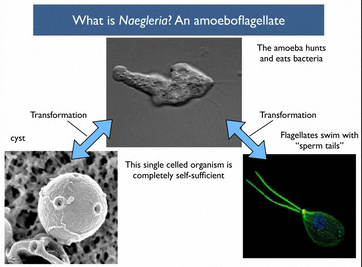Please note: Osher Rainforest will be closed for maintenance Jan. 14–16.
Science News
Amoeba Genes Reveal our Past
March 8, 2010

Vampires and werewolves capture our imaginations with their ability to change shape—from human to animal and back. Wouldn’t it be great if we could change form at will?
Real humans, with our trillions of cells, cannot do this. But a single-celled creature called Naegleria gruberi can and now local researchers are looking to the creatures’ diverse genome hoping to get a peek into early evolution.
For over one hundred years scientists have known that a Naegleria can switch from an amoeba to a flagellate when it needs to. As an amoeba, it pushes out little feet that propel it in its hunt for the bacteria it eats. But if the food becomes scarce, Naegleria will grow two flagella, kind of like sperm tails, and use them like arms to quickly swim and find food.
But wait, there’s more! If the damp mud or pond that the Naegleria lives in dries up, it can transform itself into a third form—that of a hard cyst. As a cyst, it can live in dry soil until moisture returns it to amoeba form once again.
Naegleria gruberi can be found in many places and luckily for UC Berkeley researchers, they happen to live in the mud below eucalyptus groves right on campus. When the nearby Department of Energy’s Joint Genome Institute mentioned they had some extra space for sequencing organisms, the Cal scientists decided to put the odd creature through the machine. The results were published last week in the journal Cell.
The researchers found that Naegleria have more genes than most other single-celled organisms—15,727. That’s two-thirds as many as humans—pretty amazing for an amoeba.
Also, because Naegleria exhibit two methods of movement (as an amoeba and as a flagellate), the organism can help scientists understand the origins of these parallel systems during the evolution of eukaryotes some 1.5 billion years ago.
According to UC Berkeley graduate student (and lead author) Lillian Fritz-Laylin, "By comparing diverse organisms like Naegleria from all over the family tree of eukaryotes we can begin to understand where we come from," she said.
These single-celled shapeshifters can teach us a lot!
Image courtesy of DOE JGI